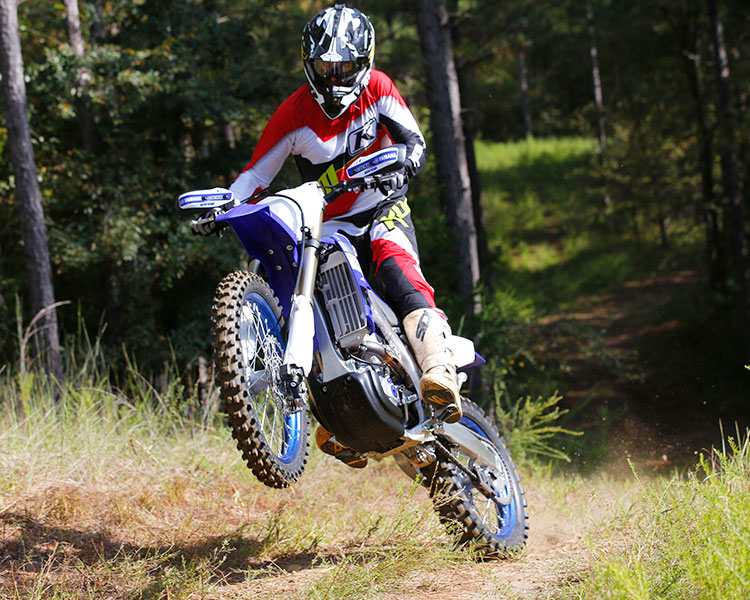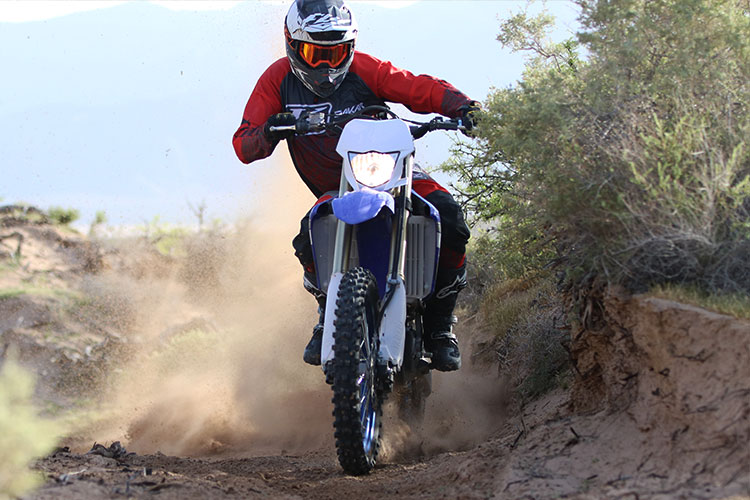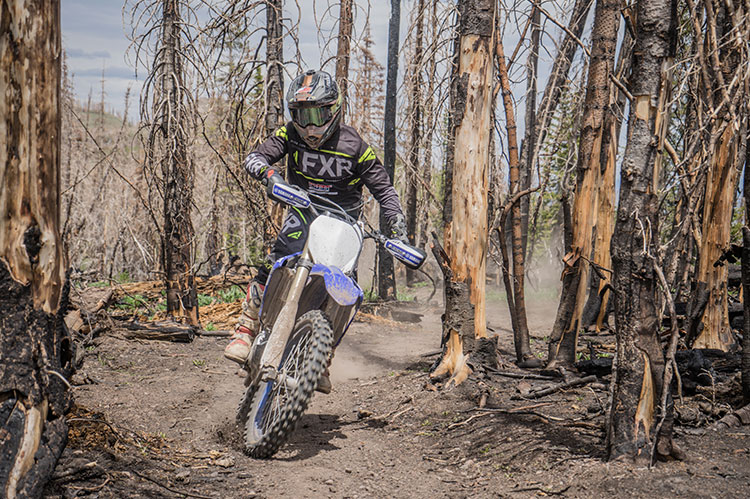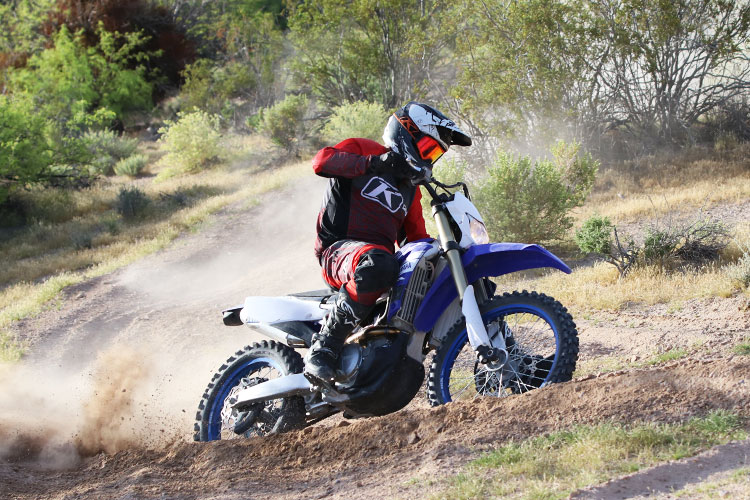The Blue War
Story by Jimmy Lewis/Trevor Hunter; Photos by Craig Hunter/Gabe Adams

On paper, Yamaha’s off-road bikes have their designated purpose with the FX and WR lineups, but we’ve found the YZ450FX and WR450F to be a lot more similar than one might think. The FX is the bLU cRU’s designated race bike and designed for competition use, while the WR is the trail oriented bike that was supposed to be a “green sticker” bike till some of the regulations changed last minute having to do with evaporative emissions meaning the use of a charcoal container. So the WR is currently a “red sticker” bike but is still quiet and spark arrested so for most places plenty off-road legal. With that being said, a few simple modifications will unlock the WR’s performance and make it nearly identical with the FX if the rider is looking that directions. We for sure were.

First thing’s first. We modified the WR a bit to get it up to speed like most, if not all, WR owners do. First, we removed the throttle stop to get full throttle activation. Second, we removed the restrictor out of the intake to open up the airbox and get normal airflow out of it. Third, we took off the exhaust system and installed an FMF system with a Q4 muffler or a GYTR muffler and a PowerBomb header. The stock muffler has a small restrictor which can be removed separately that will give your bike more performance, but it still remains very quiet and fairly heavy. Finally, we installed the all important Yamaha Competition ECU. It’s very similar to the FX ECU and turns it into more of a moto style power delivery. With these four changes, the motor package is nearly identical to that of the 450FX race bike.

With the motor being similar, what else differentiates these two bikes? The WR has the same KYB suspension components, just with softer valving designed for trail riding. Additionally, it comes with a cooling fan on the radiator, a headlight and taillight, a steel rear sprocket, and a speedo.

So, how do they compare once out on the track or trails? Strikingly similar, but different enough to cater to different riding styles. The FX is a pure bred race bike plain and simple. It’s more closely related to its motocross cousin – the YZ450F. As a result, the suspension is much stiffer and can handle a wider variety of terrain leaning all the way to MX use for those inclined.. If you plan on hitting the motocross tracks from time to time, the FX suspension is much better suited and equipped to handle big braking bumps and hard landings off jumps. The more of-road spec lets the bike use more of the stroke than an MX setting and that has the bike acting different on the impacts. Faster riders find the bike wallowly on jump faces where slower riders get more bottoming out when landing off jumps. And all of these traits are further exemplified on the WR if used on a moto track.

Our younger tester who is accustomed to a stiff race bike feel favored the FX suspension more often than not for its stiff nature and confidence inspiring feel. On fast GP terrain or moto tracks, the FX has the upper hand. However, once things slow down and 1st and 2nd gear come into play, the WR struts its legs. The soft, supple feel of the WR suspension soaks up anything and everything thrown its way. The WR suspenders have a soft initial feel, but maintains a progressive rate as it gets deeper into the stroke and reacts quite well to bottoming – something we find translates across the entire Yamaha lineup. As we ventured off the beaten path or found ourselves in the trees, the WR became more appealing, even for the young whippersnapper looking to race through everything. Here the WR finds traction and adds comfort. For us it is a simple decision. Do you want to go on the motocross track with the stock suspension? If so, pick the FX. If you want to go that far with the WR, you’ll need some valving modifications. Same for the FX. Going into the trees a lot, the components will need a little internal massaging. Riding both of the bike is the best way to see how different setups have advantages and disadvantages.

Onto the power, our motors were pretty much identical with the modifications we performed on the WR to open it up. However, we tried a few different mufflers on the bikes with an FMF Q4 and header on the WR while a GYTR Powercore 4 adorned the back of the FX. Both our older and younger testers preferred the Q4 exhaust for its smooth, easy to ride power delivery while also keeping noise down a bit. The GYTR exhaust was noticeably louder with a sharp snappy tone. That sound matched the power delivery and and made the bike much harder to handle and hold on to unless we used the Power Tuner app to de-tune the bike to a more off-road power delivery..

Yamaha’s handy Power Tuner App is the best thing about these bikes in our opinion, and it is free! Well, for the WR you need the competition ECU. It helped nullify the engine characteristic differences as we were able to play with the mapping in each bike and fine tune the power to something each rider liked. Depending on the terrain of the day or the rider aboard, we could tailor the bike in a matter of seconds. You could make the FX WR tame or the WR as much of a YZ as you likes. Or find a happy place anywhere in between.

Some other key differences between these two bikes are the added accessories that graces the WR. A speedo, fan, and lights are found on the trail oriented bike but left off of the race bike. Yes, it adds some weight on the scale, but the weight isn’t felt out on the trail. Turning and maneuvering each bike felt the same as if each had the exact same weight on the scale. Especially when the WR muffler is replaced, they both feel very light and nimble for 450cc machines. Additionally, when things got tight and technical, the cooling fan on the WR kicked in and helped avoid overheating while our FX was struggling a bit more. Installing a fan kit on your FX is definitely a recommended add-on if you plan on riding in technical or extreme terrain.

Overall, both the YZ450FX and WR450F are quite similar, yet different machines and each caters to a different market. If plans are to hit big jumps or race at high speeds (especially desert racing), then the FX is the more adept bike. But, if the pace slows or you’re looking for more comfort than performance in the suspension, then the WR has the upper hand. The one downside to the WR is it takes a small amount of work and money to truly unlock its potential while the FX is ready off the showroom floor. However, the WR is just as capable and comes with a host of features that the FX doesn’t offer which can come in handy out on the trail.

For more info on these bikes see:
2019 Yamaha WR450F Riding Impression
2019 Yamaha YZ450FX Riding Impression & Video
2019 Yamaha YZ450FX Official Site
2019 Yamaha WR450F Official Site
Support DBT by sharing the our videos and shopping and searching through the links below:


